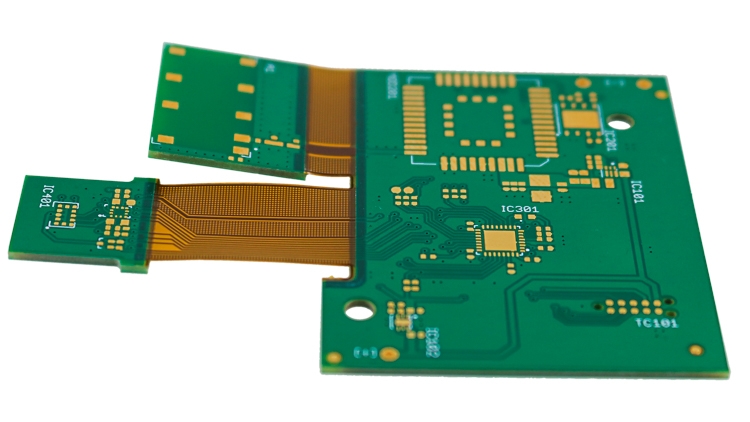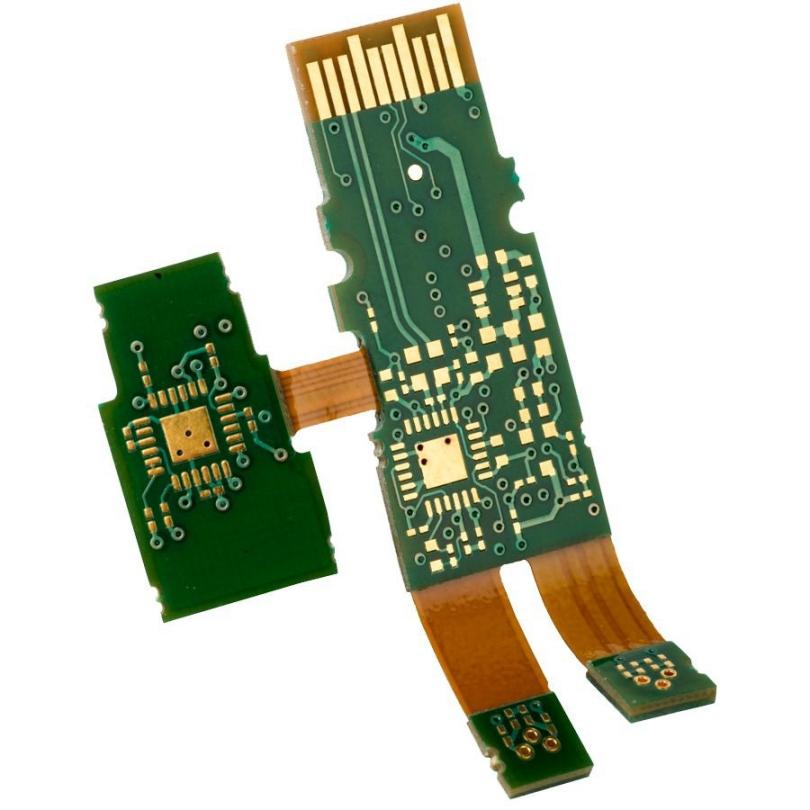Rigid-flex circuit boards combine the robustness of rigid PCBs with the versatility of flexible circuits, offering a hybrid design that enhances the functionality and reliability of electronic devices. These boards are pivotal in modern electronics due to their ability to conform to limited spaces and complex shapes, making them indispensable in everything from smartphones to advanced medical devices. This introduction explores the innovations in rigid-flex circuit boards, emphasizing how their design flexibility is driving advancements in electronic device manufacturing.

Basics of Rigid-Flex Circuit Boards
Explanation of Rigid and Flexible Components
A Rigid-Flexible Circuit (rigid-flex circuit board) is a sophisticated assembly that integrates the stability of rigid circuit boards with the flexibility of flexible circuits. This hybrid design utilizes an epoxy pre-preg bonding film for mechanical joining, while electrical connections are established through plated through holes (PTH) and vias. The configuration resembles a multi-layer flex circuit, combining different layers to optimize electronic performance and device integration.
Best FPC Manufacturing Process Overview
For over two decades, rigid-flex circuits have been a staple in critical applications such as military and aerospace. These boards may feature multiple flexible circuit inner layers within a multilayer setup, accommodating flexible layers both externally and internally depending on the design requirements. Best Technology, a leading manufacturer, crafts rigid-flex circuits with optional outer flexible layers, tailoring to complex electronic designs and enhancing functional integration.
Advantages Over Traditional Rigid Boards
Best Technology, a premier provider in China, offers rigid-flex circuit boards that surpass traditional rigid boards in versatility and performance. Capable of producing boards with up to 10 flexible layers and 40 rigid layers, accommodating designs up to 50 layers, the company caters to a wide range of technical demands. Material options include polyimide for flex cores and variable copper thicknesses for enhanced conductivity. Features such as coverlays, stiffeners, EMI/RF shielding, and controlled impedance are customizable. Adhering to IPC 6013 standards for Class II & III, Best Technology ensures high reliability and durability in its products.
Current Applications of Rigid-Flex Circuit Boards
Aerospace and Defense Industries
In aerospace and defense, reliability under extreme conditions is non-negotiable. Rigid-flex circuit boards are crucial for equipment where mechanical stability and flexibility are required, such as in satellites, avionics, and military communications gear. Their ability to withstand vibrations and thermal stress while maintaining lightweight attributes is invaluable.
Medical Devices
The medical sector benefits greatly from rigid-flex technology. Devices like implants, wearables, and diagnostic equipment utilize these circuits for their compact size and reliability. The flexibility allows for more ergonomic designs in wearable devices, while the rigidity ensures longevity and stability in critical internal components.
Consumer Electronics
Consumer electronics have seen a significant transformation with the adoption of rigid-flex boards. These circuits are found in smartphones, tablets, and wearable tech, providing thin, lightweight solutions that accommodate the sleek designs of modern devices. Their flexibility is crucial for integrating more features into smaller spaces without compromising on performance.
Automotive Sector
Automotive technology increasingly relies on rigid-flex circuits for applications ranging from dashboard instrumentation to sensors and cameras. These circuits are designed to endure the automotive environment, offering resistance to shock, moisture, and long-term wear. The integration of flexible elements allows for innovative design approaches in increasingly electronic vehicles, supporting the shift towards more autonomous and connected features.

Advantages of Best FPC Rigid-Flex Circuit Boards
High-Density Application Compatibility
Best FPC's rigid-flex circuits are optimized for high-density applications. They utilize rigid areas for component mounting while employing flexible sections for fine line routing, allowing for denser component placement and slimmer conductors. This configuration supports the trend towards miniaturization in electronics, making it ideal for complex assemblies where space and weight are critical constraints.
Versatility Across Industries
The versatility of Best FPC's rigid-flex circuit boards is evident in their broad application spectrum, encompassing communication, consumer electronics, medical devices, and military equipment. This adaptability is facilitated by the unique properties of rigid-flex boards, which can be tailored to meet specific industry needs such as durability, flexibility, and high performance in compact forms.
Enhanced Design Features
Best FPC rigid-flex boards come equipped with a range of advanced features to meet diverse design requirements. These include air gaps for improved electrical insulation, controlled impedance for stable signal transmission, and EMI shielding to protect against electromagnetic interference. Additionally, options for stiffeners provide structural support where needed, further enhancing the circuit's reliability and functionality. These features collectively contribute to reducing package size and weight while optimizing the assembly and integration process, making these boards a preferred choice for designers seeking efficient and innovative solutions.
Future Trends and Emerging Technologies
Integration with IoT and Wearable Devices
The integration of rigid-flex circuit boards with the Internet of Things (IoT) and wearable technology marks a significant trend. As electronic devices evolve to become more interconnected and data-centric, the compact, efficient, and highly functional designs enabled by rigid-flex PCBs become crucial. These boards facilitate the seamless integration of sensors, connectivity modules, and essential components required for smart devices.
Enhanced Flexibility and Durability
Technological advancements are increasingly focusing on enhancing the mechanical flexibility and durability of rigid-flex boards to cope with dynamic and harsh environments. This involves improving the materials' elastic properties in the flexible sections of the boards, enabling extreme bending and extended lifecycles without compromising circuit integrity.
Adoption of Novel Materials
The use of innovative materials such as liquid crystal polymers (LCP), conductive inks, and advanced composites is poised to transform rigid-flex circuit manufacturing. These materials provide enhanced thermal stability, chemical resistance, and electrical properties, meeting the demands of the next generation of high-performance electronics.
Advances in Nanotechnology and Flexible Electronics
Nanotechnology is crucial in the ongoing development of rigid-flex circuits, facilitating the production of components that are thinner, lighter, and more energy-efficient. Coupled with advancements in flexible electronics, these innovations promote significant improvements in microfabrication and nano-scale engineering, which pave the way for more compact and powerful electronic devices.
Case Studies and Real-World Examples
Flexible PCBs in Smartphones and Tablets
Flexible PCBs are increasingly utilized in smartphones and tablets to support their sleek and lightweight designs. Rigid-flex circuits in these devices manage to compactly house complex, multi-functional components, enhancing overall performance and user experience.
Rigid-Flex Applications in Medical Implants
Rigid-flex technology is crucial in medical implants, such as pacemakers and biosensors. These applications demand materials that are not only reliable and biocompatible but also capable of performing under physiological conditions. Rigid-flex PCBs offer customizable designs and durability, making them ideal for such sensitive uses.
Automotive Industry Use Cases
Rigid-flex PCBs find extensive use in the automotive industry, from dashboard displays to intricate sensor systems. These circuits facilitate the industry's shift toward more integrated and intelligent systems, offering solutions that can endure automotive-specific challenges like vibrations and temperature fluctuations.
Military and Aerospace Innovations
In military and aerospace applications, rigid-flex PCBs are essential for critical tasks such as satellite communications and avionic controls. These sectors require exceptionally high standards for reliability and performance, especially under extreme conditions—areas where the unique properties of rigid-flex boards are fundamentally important for success.
In Sum
Rigid-flex circuit boards represent a transformative advancement in the field of electronics, seamlessly blending flexibility with structural integrity. As we've seen, their integration into industries such as aerospace, consumer electronics, automotive, and medical devices demonstrates their versatility and critical role in modern technology. The future promises further enhancements through innovative materials and nanotechnology, making these boards even more integral to the development of compact, efficient, and high-performing devices. Embracing these innovations, rigid-flex PCBs continue to be at the forefront of electronic design, providing reliable and adaptable solutions that meet the dynamic demands of today's technological landscape.










 2024-05-22
2024-05-22
 BEST
BEST

.png)
.png)
.png)
.png)

.png)

